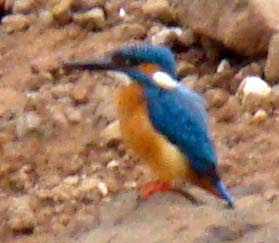Pied Kingfisher :
Ceryle rudis
Size 17 cm
Characteristics : There is a place on the outskirts of Pune
where three rivers, the Bhima, Bhama and Indrani, meet and therefore called the
Triveni Sangam. I go there only to see this bird fish. It is a most amazing
sight. The bright looking bird, with its black and white plumage perched atop a
tree or hovering over the lake occasionally plunging down and going up again
(probably when losing sight of its prey) and then going for a smart swoop and coming
up with its prey in its mouth.
 |
| Eyeing the prey |
 |
| Hovering above the prey |
 |
| The swoop down in the water |
The males have double breast bands, one broad one thin,
(like the one in the picture above) whereas, the females have a single broad
band often broken in the middle. Both have a small black crest.
Distribution: It is a widespread resident bird. An
interesting fact is that it is the world’s third most common kingfisher. They
are found near still, fresh water bodies, slow moving rivers and streams, also
tidal creeks and pools where acquatic creatures and fish are to be found.
Diet : Mostly fish butalso feeds on large acquatic insects
and crustaceans.
Breeding : The pied kingfisher nests in 4-5 feet deep holes
in mud banks near a water body.
White throated Kingfisher :
Halcyon smymensis
Size 28 cm
 |
| Reason it is called 'white throated' |
 |
| A little painting I made |
Characteristics : Compared to the other two of its specie, the
white throated or white breasted kingfisher is rather large in size. It has a
bright blue back, wings and tail and chestnut head, shoulders, flanks and lower
belly. The large bill and legs are bright red. In flight white patches can be
seen on its blue-black wings. The male and the female are alike.
Distribution : Most commonly seen kingfisher is a widespread
resident. Unlike the other two kingfishers on this page, it can be found even
in places away from water. As it is not choosy about its diet and is not
predated upon because of its strong bill and swift flight, the white throated
kingfisher’s population is not threatened. :-)
Diet : It feeds on any small creature, sometimes, even,
small birds.
Breeding : They nest in excavated tunnels about 50 cm or
more in mud walls. 4-7 round white eggs take 20-22 days to hatch.
Common Kingfisher :
Alcedo atthis
Size 18 cm
Distribution : It is a widespread resident bird. They are
found near any water body which has some acquatic creatures. If I don’t see
this bird when I am on a beach or a lake I feel a little heart-broken. It is
such a cheery sight to see a patch of bright blue and orange, sitting
motionless, on a rock.
Characteristics : They have bright blue upper parts and orange
under parts and ear coverts. There are white patches on each side of their neck
and chin. The legs are red with a blue stripe. The male has a black bill and
the female has a black bill with a reddish base.
Diet: They feed on fish, acquatic invertebrates and amphibians.
Sitting motionless on a perch and diving to catch their prey, which they gobble,
head first, after coming back to their perch.
Breeding : Common Kingfishers can nest upto three times a
year – in April, July and October.They nest in tunnels, 2-3 feet in length in
the sand near a water body. They line the nest with fish bones and disgorged
pellets (a bed of thorns!). The female lays 5-7 pinkish eggs which both
incubate in turn and also when hatched both parents feed them. Which is just as
well, because each chick can eat 12 – 18 fish per day. After about a month the
chicks are driven out of the territory.


